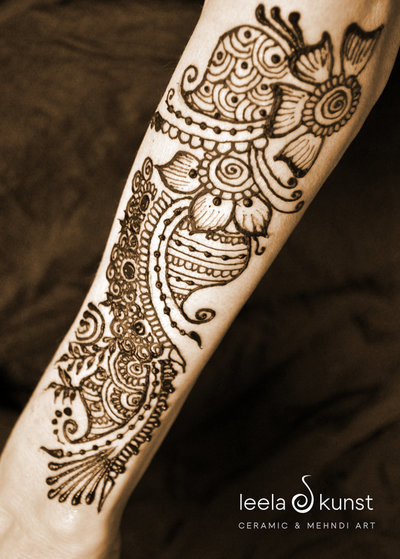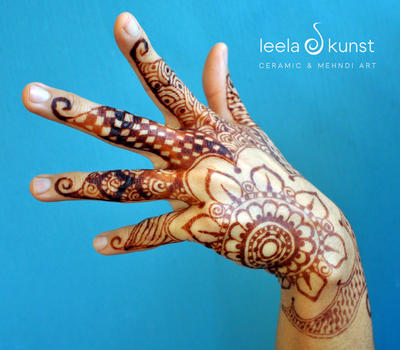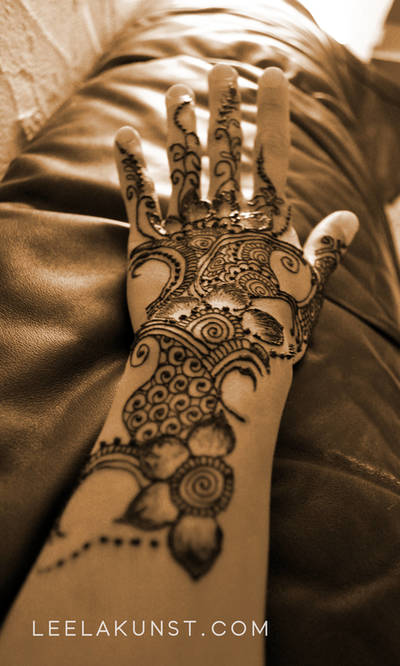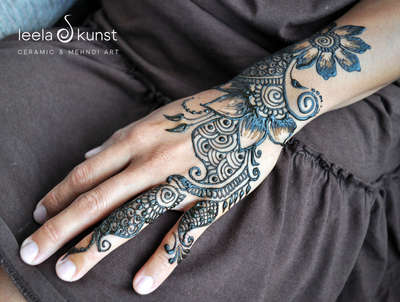Henna
Henna (aka Mehndi) is temporary body art which originated in Ancient Egypt and has been around for more than 5000 years. It uses a natural paste made from the leaves of the henna tree to draw on the body. The leaves, with its natural dyeing properties, are first dried, crushed, then mixed into a paste, and applied with various pointy tools (I use self-made cones). In India, Africa and the Middle East, henna adorn women's bodies as part of celebrations (e.g. weddings, births, birthdays). Men also get henna during festivals and weddings, though this is more common in the East. Mehndi art has now spread all over the world and is embraced in the West as a beautiful body decoration.
100% Natural Henna
I mix my own Henna paste with all natural and organic ingredients. For the list, please scroll below to the FAQs.
For all private & corporate booking prices, please look here. |
Prenatal Henna
Getting a prenatal henna is a fantastic way for mothers-to-be to pamper themselves and it's also a way to bless their babies. Traditionally, mothers will beautify their hands and feet with henna to celebrate the coming of their child, now it has also become popular to paint their bellies.
I prepare especially for pregnant mothers a henna paste that only contains lavender oil, which is known to be a very low-risk skin allergen. (If you are still unsure if you respond well to my paste, we could make a spot test on you first.)
If you would like to get a prenatal henna please make an appointment when you are in your 7th or 8th month. A private prenatal henna session will take place comfortably in your home. It can take 1 to 2 hours, depending on how complicated or large the pattern is. The session costs 80€-130€ and includes a personal henna design of your choice. If you are interested, just get in touch. I would be happy to share my art with you during this special time in your life!
I prepare especially for pregnant mothers a henna paste that only contains lavender oil, which is known to be a very low-risk skin allergen. (If you are still unsure if you respond well to my paste, we could make a spot test on you first.)
If you would like to get a prenatal henna please make an appointment when you are in your 7th or 8th month. A private prenatal henna session will take place comfortably in your home. It can take 1 to 2 hours, depending on how complicated or large the pattern is. The session costs 80€-130€ and includes a personal henna design of your choice. If you are interested, just get in touch. I would be happy to share my art with you during this special time in your life!
FAQ
What are the ingredients in your henna paste?
My henna paste is homemade and consists of 100% natural ingredients: organic lemon juice, premium henna powder (I use Jamila, a highly-favored brand by professional henna artists), organic sugar, organic cajeput essential oil (a kind of tea tree) and organic lavender essential oil.
My henna paste is homemade and consists of 100% natural ingredients: organic lemon juice, premium henna powder (I use Jamila, a highly-favored brand by professional henna artists), organic sugar, organic cajeput essential oil (a kind of tea tree) and organic lavender essential oil.

"Henna Leaves" by 235uranium / CC BY 3.0
How long should I keep henna on my skin?
As long as possible. Keep the paste on your skin for at least 6 hours. For best results, 8 hours or overnight (sleeping with it is fine). Afterwards it can be scratched off with your fingernails or scraped off with a butter knife. DO NOT wash with water as that can prevent the stain from darkening. For hard-to-remove areas, moisten your skin with any plant-based oil (e.g. olive) and continue to scratch it off.
As long as possible. Keep the paste on your skin for at least 6 hours. For best results, 8 hours or overnight (sleeping with it is fine). Afterwards it can be scratched off with your fingernails or scraped off with a butter knife. DO NOT wash with water as that can prevent the stain from darkening. For hard-to-remove areas, moisten your skin with any plant-based oil (e.g. olive) and continue to scratch it off.
How dark does henna stain?
The henna paste dyes the outer layer of the skin. The stain looks orange at first and develops into a brown/burgundy color during the next days. It is quite exciting to see the changes as the time goes by! How dark the stain gets depends on many varying conditions like climate, temperature, skin type, age, and also on where it is drawn on the body. Also the thicker the skin, the darker it becomes: hands and feet produce the best stain, next best are wrists and legs, while the torso, back and face produce the lightest stain.
The henna paste dyes the outer layer of the skin. The stain looks orange at first and develops into a brown/burgundy color during the next days. It is quite exciting to see the changes as the time goes by! How dark the stain gets depends on many varying conditions like climate, temperature, skin type, age, and also on where it is drawn on the body. Also the thicker the skin, the darker it becomes: hands and feet produce the best stain, next best are wrists and legs, while the torso, back and face produce the lightest stain.
How long does the stain last?
The stain usually lasts 7-14 days. Much of it depends on how you take care of it and how often your skin renews itself.
The stain usually lasts 7-14 days. Much of it depends on how you take care of it and how often your skin renews itself.
How do I take care of my henna stain?
Generously moisturize your henna with any plant-based oil such as olive, coconut or Shea butter (anything good for the skin is good for your stain). This helps protect the henna stain from water — so grease-up before showering! Try not to get any water on the stain and avoid harsh soap and detergents for at least 24 hours.
Generously moisturize your henna with any plant-based oil such as olive, coconut or Shea butter (anything good for the skin is good for your stain). This helps protect the henna stain from water — so grease-up before showering! Try not to get any water on the stain and avoid harsh soap and detergents for at least 24 hours.
Is henna body art safe?
Absolutely, especially if the paste is made with pure, chemical-free ingredients. I make my own paste with 100% natural henna and aromatherapy grade essential oils. Besides that, the henna plant is known for its medicinal properties. It works as a natural anti-inflammatory and has antifungal and antibacterial properties. Its bark, oil, leaves and seeds can be used as a remedy for many illnesses from fevers to headaches, to lowering blood pressure and healing wounds. As a natural beauty treatment, henna has been known to even strengthen hair and fingernails. Remember, mehndi art has been around for thousands of years if that can't already be a testament to its safety!
Note: I do not recommend store-bought hennas, especially black-colored henna, as they are rarely free of chemicals you would not want to have on your body! (see below: "Black Henna - Warning!")
Absolutely, especially if the paste is made with pure, chemical-free ingredients. I make my own paste with 100% natural henna and aromatherapy grade essential oils. Besides that, the henna plant is known for its medicinal properties. It works as a natural anti-inflammatory and has antifungal and antibacterial properties. Its bark, oil, leaves and seeds can be used as a remedy for many illnesses from fevers to headaches, to lowering blood pressure and healing wounds. As a natural beauty treatment, henna has been known to even strengthen hair and fingernails. Remember, mehndi art has been around for thousands of years if that can't already be a testament to its safety!
Note: I do not recommend store-bought hennas, especially black-colored henna, as they are rarely free of chemicals you would not want to have on your body! (see below: "Black Henna - Warning!")
Am I allergic to henna?
Henna allergy is very rare. That said, if you have a G6PD deficiency, a hereditary disease commonly found among people of African and Mediterranean origins, it is advised you can have only small applications of henna, or avoid it altogether if you are anemic or have an infectious disease. Children under 6 years old with this condition should not get henna.
Henna allergy is very rare. That said, if you have a G6PD deficiency, a hereditary disease commonly found among people of African and Mediterranean origins, it is advised you can have only small applications of henna, or avoid it altogether if you are anemic or have an infectious disease. Children under 6 years old with this condition should not get henna.
Is it safe during pregnancy?
Yes, if it is natural henna and consists of only lavender essential oil. Henna has been used for centuries as a blessing and protection over pregnant mothers. There are very lovely mehndi designs for pregnant mothers and their bellies!
Yes, if it is natural henna and consists of only lavender essential oil. Henna has been used for centuries as a blessing and protection over pregnant mothers. There are very lovely mehndi designs for pregnant mothers and their bellies!
Is it safe for children?
Yes. In some counties, as a form of blessing and protection, babies at 1-2 months of age get henna on their soles and palms, some even the full body. Children under 6 with G6PD deficiency should not get henna.
Yes. In some counties, as a form of blessing and protection, babies at 1-2 months of age get henna on their soles and palms, some even the full body. Children under 6 with G6PD deficiency should not get henna.
Black Henna - Warning!
Real traditional henna is never black. To make it black, PPD (Para-phenylenediamine) is often added to the henna paste in order to darken and speed up the stain. PPD is a synthetic coal tar dye and some people can have severe allergic reactions when it comes into contact on their skin. Some symptoms include wheezing, itching, redness, blistering and swelling of the skin. This stuff can have serious implications for your health — so I recommend that you avoid it!
Real traditional henna is never black. To make it black, PPD (Para-phenylenediamine) is often added to the henna paste in order to darken and speed up the stain. PPD is a synthetic coal tar dye and some people can have severe allergic reactions when it comes into contact on their skin. Some symptoms include wheezing, itching, redness, blistering and swelling of the skin. This stuff can have serious implications for your health — so I recommend that you avoid it!
© 2017-2024 Leela Kunst. Website by Jeannette Lee | Impressum/Legal Disclosure | Datenschutz/Privacy
























